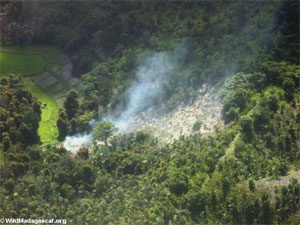Madagascar establishes new park system to protect lemurs, benefit people
IRIN, a UN humanitarian news and information service
January 17, 2006
MAHITSIARONGANA, 17 January (IRIN) – President Marc Ravalomanana’s government has embarked on an ambitious national effort to protect Madagascar’s remaining biodiversity while simultaneously reducing poverty and promoting rural development.
In September 2003 he announced his commitment to triple Madagascar’s protected areas in five years at the World Parks Congress in Durban, South Africa. Christened “the Durban Vision”, the plan would increase the country’s protected habitats from 1.7 to 6 million hectares – or from 3 to 10 percent of the Indian Ocean nation’s surface area.
Despite being renowned for its globally unique biodiversity, Madagascar has seen its forests reduced to only 10 percent of their original cover. With deforestation continuing at an annual rate of 2,000 km2 – largely to meet the livelihood needs of expanding rural populations – this protection pledge may have come just in time.
A three-day walk separates Mahitsiarongana village in Madagascar’s remote northeast from the nearest town. Men, women and children trickle in from the bush to the village’s muddy center – word of mouth has summoned them from the distant rice fields where the majority stay during the planting season.
The village president finally introduces the six conspicuously urban Malagasy who have arrived, saying, “They’re here to help us manage the forest.”
 Forest clearing in Madagascar |
During the half-hour meeting the villagers are told the forest around their lands will soon be protected by something called the Makira Project, but are assured that they can remain in the area, and will have management rights to the forest they have used for generations.
Last month, the Ministry of Environment, Water and Forests (MINENVEF) signed off on the first Durban Vision sites, totalling a massive one million hectares. Another major success was the creation of the country’s new System of Protected Areas of Madagascar, or SAPM, which redefines and simplifies the legal process used to create a protected area.
“I think that perhaps even more important that the million [ha] is the fact that after only two years we were able to create the SAPM. It’s not 100 percent fixed, but now we have a clear procedure and legal basis in place. Without it things were much more difficult,” said Lantoniaina Andriamampianina, Madagascar Terrestrial Programme Director of the Wildlife Conservation Society (WCS), a US-based NGO involved in the Durban Vision process.
Prior to SAPM, Madagascar’s protected areas network was run by the national park service, ANGAP. It followed the classic national park model of protected areas in which tourism and/or research was allowed, but any type of extraction, much less habitation, was strictly prohibited.
 Tavy, or forest burning, in Madagascar Related articles Lemur land, Madagascar now protected. Madagascar is one of the world’s most special places. An island slightly larger than the state of California, Madagascar is home to a bewildering array of wildlife from dancing lemurs to absurdly colorful chameleons. Eighty percent of the island’s species are endemic, meaning they are found nowhere else on Earth. Group completes first megatransect of Madagascar. |
Under the more flexible SAPM, varying degrees of sustainable resource use can be permitted in new sites, contributing to poverty reduction and sustainable development.
As the world’s 11th poorest nation, with an illiteracy rate approaching 50 percent, Madagascar lacks the resources – both financial and human – to undertake the management of six million ha of new protected areas.
Illegal mining and logging head the list of commercial menaces, and a growing population’s continued practice of the slash-and-burn agriculture that is responsible for most of Madagascar’s deforestation means managers will have their hands full.
However, both MINENVEF and NGOs have high hopes of building capacity in rural communities, so that local people might take on a significant portion of the cost of management.
Communities and the government enter a legal contract in which community associations (called COBAs) are given management rights to important conservation areas. The COBAs agree to manage those areas according to conservation objectives, and in theory can profit from this agreement, whether indirectly through exclusive rights to important resources, or directly through activities such as ecotourism ventures, or selling permits to outsiders seeking to use resources.
In Mahitsiarongana the meeting to appoint leaders for the community’s new COBA had adjourned. Opinions and understanding of what has occurred were mixed. Many claimed not to understand what was being discussed. When pressed, most said they know they’re supposed to protect the forest, but when asked what that meant, many couldn’t explain.
Serge Rajaobelina, executive secretary of FANAMBY, a national environmental NGO, acknowledged the difficulties of transferring management to communities.
“It would be a bit like asking you to fly a 747 tomorrow. We’ve got a long way to go … we’re trying to figure out the best ways to teach, train, and work with the communities; to find solutions and strategies both for the conservation issues and the development issues.”
There is much to do before Madagascar can fulfil the ambitious commitment to both its natural heritage and its people. However, those leading the process appear realistic yet hopeful.
“The environment sector must take part in the fight against poverty. And not only environment – all the different sectors of government must find ways to work together,” Jean Philippe Randrianantoandro, MINENVEF’s focal point for the Durban Vision told IRIN.
“I’m sure the people would prefer to conserve the environment if given a choice – but it’s a question of survival.”
This is a modified news article provided by IRIN, a UN humanitarian news and information service